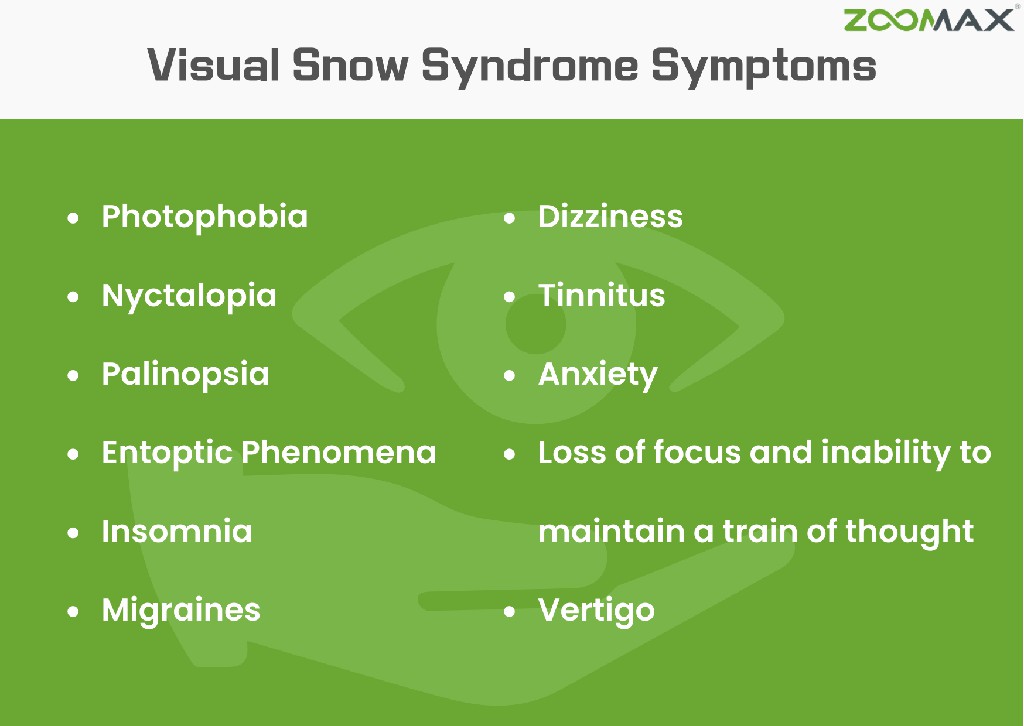Our eyes are one of the most important organs in terms of how we experience life and the world around us. But like any part of the body, they can be compromised by injury or disease, causing sight issues of varying degrees. There are a number of diseases that affect eyesight, some of which are quite rare, and Visual Snow Syndrome is one of them. While this is not a disease that means a loss of sight, it does cause a form of sight impairment. Here is everything you need to know about this rare eye disorder.

What is Visual Snow Syndrome?
It is an eye disorder that causes the affected person to see tiny dots everywhere they look. Visual Snow Syndrome symptoms are often likened to static, or when you shake a snow globe, lots of small dots that obscure the view. The technical description for the disease is as follows:
“Visual snow (VS) is a form of visual hallucination that is characterized by the perception of small, bilateral, simultaneous, diffuse, mobile, asynchronous dots usually throughout the entire visual field, but it can be partial, and it is present in all conditions of illumination, even with the eyes closed. The dots remain individual and do not clump together or change in size.”
The dots can appear the same color as the background, or be the opposite, so that Visual Snow Syndrome in the dark will display light dots, and dark dots in the light. Visual Snow Syndrome is considered a chronic disease, and can be highly disabling due to the severity of the visual impairment and accompanying symptoms.
 A study by Kondziella et al in 2020 looked at how prevalent the syndrome is and found that around 2.2% of people tested met the criteria for Visual Snow Syndrome, with a mean age of 50.6 years. There is still uncertainty for Visual Snow Syndrome causes, but studies are finding correlation with migraine and tinnitus, as well as connections to other issues such as anxiety.
A study by Kondziella et al in 2020 looked at how prevalent the syndrome is and found that around 2.2% of people tested met the criteria for Visual Snow Syndrome, with a mean age of 50.6 years. There is still uncertainty for Visual Snow Syndrome causes, but studies are finding correlation with migraine and tinnitus, as well as connections to other issues such as anxiety.
What are the Symptoms of Visual Snow Syndrome?
Visual Snow Syndrome is signified by the static-like dots that obscure someone’s vision, but there are a number of other symptoms that can accompany the issue.
These include:
- Photophobia – This is when your eyes are particularly sensitive to brighter light.
- Nyctalopia – Finding it difficult to see at night or in low light situations.
- Palinopsia – A condition where you see a trail of an object after it has moved out of your vision.
- Entoptic Phenomena – Seeing images in the eye that are not there, such as still seeing a light when you close your eyes.
There are other non-visual symptoms too, including:
- Tinnitus – A ringing or buzzing in the ears.
- Anxiety
- Loss of focus and inability to maintain a train of thought
- Insomnia – Difficulty sleeping.
- Migraines
- Dizziness – Can be accompanied by vomiting
- Vertigo

Work is still being done to establish the causes of Visual Snow Syndrome, although previously studies were hampered by small sample sizes, today progress is being made. While no firm understanding of the Visual Snow Syndrome causes has been established, researchers do believe that it is a type of brain disorder.
While in many cases, visual snow syndrome symptoms remain isolated, studies into the condition have identified other disorders that can occur alongside it. These include stress, dyslexia, autism spectrum disorder, migraine with aura and anxiety of all kinds. However, there is no established and defined link, and research is ongoing.
How to treat Visual Snow Syndrome?
Because there is no Visual Snow Syndrome test, establishing if a patient is suffering from it can be a challenge in itself. In fact, Visual Snow Syndrome diagnosis is focused on excluding other potential causes, and may require a number of tests, including visits to both an ophthalmologist and a neurologist. As part of this, a patient may have head CT and MRI to rule out other possible causes.
 This includes ruling out things like Migraine with Aura, drugs that could cause the snow effect or other diseases that may cause a similar visual effect. In addition to ruling out other causes of the problem, Visual Snow Syndrome diagnosis requires the patient to meet certain requirements for their condition.
This includes ruling out things like Migraine with Aura, drugs that could cause the snow effect or other diseases that may cause a similar visual effect. In addition to ruling out other causes of the problem, Visual Snow Syndrome diagnosis requires the patient to meet certain requirements for their condition.
The patient must have had the symptoms for a minimum of three months, to ensure that it is not a side effect of another issue, and must display at least two of the following four visual criteria:
- Photophobia – This is when your eyes are particularly sensitive to brighter light.
- Nyctalopia – Finding it difficult to see at night or in low light situations.
- Palinopsia – A condition where you see a trail of an object after it has moved out of your vision.
- Entoptic Phenomena – Seeing images in the eye that are not there, such as still seeing a light when you close your eyes.
Because medical professionals are still learning about the disorder and the lack of tests to identify it, diagnosis can be both time consuming and frustrating for the patient, however with ongoing research and increased awareness, improvements in care for Visual Snow Syndrome are constantly being made.
As you may expect with a disorder that remains in the early stages of research and understanding, there is no single defined treatment for patients with this problem. However, that doesn’t mean there are no options, and after seeing specialists you may be given medication to help. While there is no specific treatment, studies have shown that Nortriptyline, Carbamazepine, Lamotrigine, Naproxen, and Sertraline have all helped in decreasing symptoms for patients. In addition, there are other strategies that have been shown to deliver some levels of relief. These include lifestyle changes, such as avoiding bright lights for reading, wearing tinted glasses in daylight and other measures specialists will discuss with each patient to suit their particular situation.

It is not shown that the symptoms of visual snow cause 20/200 vision, and the disorder is not progressive, however it is not a disorder that simply disappears either. Patients tend to have bouts of chronic conditions interspersed with remission, but ongoing symptoms are to be expected. As treatment develops, it has been shown that some drugs improve symptoms for some individuals, but this varies and there is no fixed approach that works for all.
As we still do not fully understand the causes of Visual Snow Syndrome, there is no established way of avoiding it either. However, as researchers are beginning to gain a better understanding of the disorder, it is hoped that alongside improved treatment options, the underlying causes of this syndrome will also be better understood too. This will allow us to better establish ways in which patients can moderate or change their behavior to minimize the risk of Visual Snow Syndrome symptoms occurring.
As a rare condition, we are still learning about Visual Snow Syndrome, both what causes it and how to treat it. A chronic condition, it can be debilitating for sufferers, not just visually but with its associated symptoms that affect every aspect of life. Ongoing research promises a better understanding of this problem, but right now it can be challenging to diagnose and difficult to respond to, although some treatments are showing promise.
References
https://my.clevelandclinic.org/health/diseases/24444-visual-snow-syndrome
https://eyewiki.aao.org/Visual_Snow
https://rarediseases.org/rare-diseases/visual-snow-syndrome/

